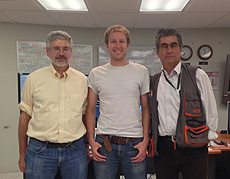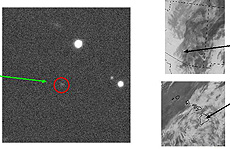To catch a falling asteroid: Dark Energy Camera scientists locate object passing Earth
 |
This Dark Energy Survey observing team was on shift at the Dark Energy Camera in Chile when they got the call to check out a potentially hazardous asteroid. From left: Steve Kent (Fermilab and University of Chicago), Alex Drlica-Wagner (Fermilab) and Hernan Tirado, telescope operator at the Cerro-Tololo Inter-American Observatory, where DECam is housed. Photo: Sara Barber, University of Oklahoma
|
For seven minutes earlier this month, two Fermilab physicists moonlighted as astronomers who, like the Men in Black, were positioned to protect the Earth from the scum of the universe.
On Feb. 3, Alex Drlica-Wagner and Steve Kent were in Chile taking data for the Dark Energy Survey when they received an email stating that a satellite telescope had picked up signs of a potentially hazardous asteroid, one whose orbit might soon meet with Earth's.
The message had come from a scientist at the Jet Propulsion Laboratory. Bad weather in the northern hemisphere had foiled attempts by JPL's two go-to cameras to photograph the asteroid, hindering the lab's ability to predict its orbit. Could the Dark Energy Camera take a bit of time off from its usual task of imaging distant galaxies to take pictures of this near-Earth object?
"We know about thousands of these asteroids," said Kent, SCD. "Of course, one we didn't know about hit Russia last year, so there's a lot of interest."
Since the asteroid was new on the orbital block, astronomers had only a rough idea of where it was headed. They did know it would soon pass in line with the sun and thus be difficult to spot in photographs.
"If we didn't follow up on it within two days, they weren't going to be able to follow it up anytime soon," said Drlica-Wagner of Fermilab's Center for Particle Astrophysics. "Because of the weather and the uncertainty of the predictions, DECam was the only thing that could pull it off."
Given Chile's clear skies and DECam's large field of view, Drlica-Wagner and Kent were fairly confident they could catch the asteroid on camera in five takes, even if its predicted location was only an estimate. They punched in the coordinates JPL gave them and took their shots. Seven minutes later, they had photos.
The asteroid turned up in all five, though it wasn't immediately apparent. The images had to be processed by the National Optical Astronomy Observatory in Tucson, Ariz., and coordinates submitted to the Minor Planet Center in Cambridge, Mass., to figure out the orbit. The results were then sent to JPL.
The asteroid looked just like the faint stars that it shared the photos with, except for one characteristic — it appeared in different positions in the five images, just the way a cartoon dot would move in a flipbook.
After combining the pictures with the satellite data, the asteroid-tracking crew brought good news.
"People shouldn't be particularly worried," Drlica-Wagner said. At its closest approach to Earth on March 1, newly discovered Apollo-class asteroid 2014 BE63 will be 18 million miles away.
The Dark Energy Camera scientists were glad to come to the aid of fellow astronomers.
"In astronomy there are always things that are time-critical in nature. People will say, 'You're at the telescope. Can you do something for me?'" Kent said. "It's a bit of a tradition to help when you can."
He added jokingly, "In this case, saving the Earth was an extra factor, so we thought it was generous."
—Leah Hesla
 |
Apollo-class asteroid 2014 BE63 looks like a faint star in the images taken by the Dark Energy Camera in Chile. The two cameras that the Jet Propulsion Laboratory usually uses to photograph near-Earth objects, in Arizona and Hawaii, were hindered by cloudy weather. Click image for more information. Image courtesy of Steve Kent, SCD
|
|